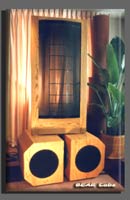

New Drivers!!
Quadripole page
 BEAR
Labs SPEAKERS (v4.04)
BEAR
Labs SPEAKERS (v4.04)
BEAR Labs designs, tests and builds outstanding
CUSTOM loudspeakers for home and professional
applications.
BEAR Labs can help you solve
problems, integrate existing components, design and furnish custom
crossovers, as well as build completely new and unique speaker systems to suit
your special needs
or installation requirements!
There are always a wide range of custom and special variations and options available.
Please check my CUSTOM
SHOP pages for general details about how Custom Shop works
and how to order custom built product.
Email me for questions and to order!
 |
 New Drivers!! |
Click image to go to
Quadripole page |
|
| Stratos |
BEAR Labs SPEAKER Systems
BEAR Labs builds a variety of speaker systems. All are made as Custom-Built products. This means that you get personal attention and consideration that would be impossible if you were buying a commercially mass-produced product. Plus, you can get a wide range of custom options for BEAR Labs Speakers:
Stratos - Three cabinet,
Cherry finished dynamic speaker system, tri-amp capable.
Zephyr - Integrated ultra hi efficiency,
large format, wide range horn system for home.
Horns - BEAR Labs can supply
unique horns, help design horns, help integrate your horns.
Ribbons - BEAR Labs is developing some innovative
Ribbon based speakers, inquire.
Drivers - You need drivers? We can get you the right
drivers.
Quadripole Subwoofers
- REAL BASS, real SLAM! New! See
The New Upgrade Drivers & Curves!
Design Concepts & Discussion
While almost every manufacturer of finished speaker systems would like you to believe that they have designed and built a speaker without compromise, the plain unvarnished fact of the matter is that all speaker technology today represents a very big compromise. In reality speaker design is more an art than a science.
Today, technology offers the speaker designer very powerful tools both in terms of simulation and measurement that were not available even 15 years ago. These tools are a great help in both the design phase and the testing phase since they give us a way to isolate and identify all manner of design aspects that formerly could only be guessed at! Even so it is not possible to even quantify and test so well that it is unnecessary to actually listen to speaker.
As often as not, if one attempts to correct one apparent design “flaw”, another is either created or revealed. So, the first step is to select the very best raw components, then the process ends up being one of balance and compromise. Striking this balance and compromise is what comprises the art of speaker design and construction.
Knowing what parts of the balance to weigh more heavily and when NOT to compromise is key. It is entirely possible to design, engineer and build a speaker system that actually measures and tests rather well but where the sound is rather less than satisfying.
There are certain design goals that I feel
a speaker ought to achieve if it is going to have a chance to be reasonably
satisfying to the listener. Remember, while I discuss these factors as
separate issues, they are actually all one - the speaker’s sound
- and they are linked so that you can not change one without altering the
others. In technical terms these
factors all linked toghether can be referred to as the
speaker’s “transfer function.”
Perhaps the most important goal is preserving “timbre and tone.” All materials, drivers and parts have and/or impart their own “sonic character” or “sonic signature.” Obviously, the less “signature” that a given system imparts upon the original signal, the purer and truer the result. In terms of measurement, a perfect speaker would have 0% THD and 0%IM.
The ultimate speaker is often defined as a point source having infinite bandwidth and dynamic range. This is the “ideal speaker”. The reason that this is considered to be the ultimate speaker is that it would have no flaws, no limitations - all sound would come from an infinitely small single point, bass through treble. In reality, this is an impossibility. But it is still the goal, the ideal.
We have to find ways to approximate this ideal speaker. How we choose to do this is where the compromises are, and where the balancing act comes in.
One of the best ways to test the quality of a speaker system is on the human voice. People are much more sensitive to minor distortions of the voice than they are to an instrument. So, this makes reproducing the human voice a good test. To do this well, the relative harmonics in the “voice range” (roughly <300Hz. To >3,000Hz.) must be kept in ratio, perfectly in balance, and true to the original. Actually, to be adjudged truly excellent, the speaker must do this over the entire audio spectrum, not just in the voice range.
If the speaker can’t be perfect (and none are), then to be consistent over the voice range is what is required at minimum. This is easy to illustrate. Consider the typical three way speaker system, or even a two way speaker system where the crossover to the tweeter is at about 1500 Hz. Every musical note consists of a fundamental tone and a series of related harmonics. The design problem is simple - as the fundamental of a given musical note rises from below 1500Hz. to above 1500Hz. (the crossover point) the ratio of sound contributed by the midrange driver and the tweeter changes! Finally above 1500Hz. only the tweeter contributes! What does this mean in terms of the sound and what is heard (and measured)??
Simply this: No speaker is ideal, nor does it have zero sonic signature
(lack of its own harmonic “coloration”),
nor
does it have an omnidirectional polar pattern, and all tweeters and woofers are
different as night and day. So as the contribution of sound shifts between the midrange and the tweeter
it changes quality and tone! This actually happens
with every speaker system
that uses more than one driver - it’s just a question of degree and at what
frequencies.
If this is not clear in your mind, then let me explain it using an analogy that somewhat exaggerates for clarity. Imagine if you will a piano concerto that is played in the following way: The left hand up to middle C is played on a full grand piano, while the right hand is played on a small upright with the top closed! While this sounds somewhat amusing, and might be an interesting effect for an avant-garde performance, it would clearly NOT sound like the concerto was being played on a single piano!
Now, to give a much better idea of what is being done when a speaker of high quality is being designed, consider that in virtually EVERY case there are at least two or more “pianos” being used! So, one of the main tasks is to try to keep the transition from one “piano” to another as smooth and unnoticeable as is possible. Not so easy! You can ignore the idea that the imaginary pianist needs to have very long arms and jump from one piano to another!
You may ask about “single driver” systems (Lowther, Jordan Modules, etc…) and planar speakers (ESLs and Planar Magnetics). Most single driver speakers suffer from a variety of shortcomings, especially in frequency response and bandwidth, but they do avoid the problem that I just described. Probably they have their followers in large part for this reason. The ESLs and planars on the other hand have the potential to avoid many of the problems that are often found in multi-way dynamic speakers, but they are not without their own set of design issues.
Well, this is only one look at what need to be taken into account when designing or building a speaker system. There are at least a dozen essential ones, and maybe a hundred more that are go along with them. All need to be considered, if the job is to be done properly. Ignoring them will not make them go away! Below is a partial list of some of the essential elements that must be considered
frequency response
bandwidth
transient response
diffraction effects
crossovers
cabinet resonance/structure
“time alignment”
impulse response
waterfall response
box losses
system/driver “Q”
efficiency/sensitivity
polar response
power handling
subjective result
... more to come!!